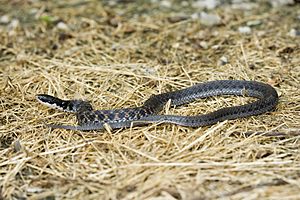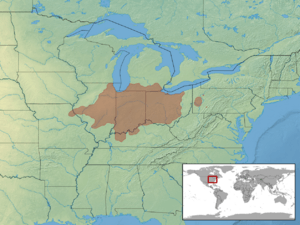Kirtland's snake facts for kids
Quick facts for kids Kirtland's snake |
|
|---|---|
 |
|
| Conservation status | |
| Scientific classification | |
| Genus: |
Clonophis
|
| Species: |
kirtlandii
|
 |
|
| Synonyms | |
|
|
The Kirtland's snake (Clonophis kirtlandii) is a special type of non-poisonous snake. It lives in North America. This snake is the only species in its group, called Clonophis. It is quite rare. Because its numbers are shrinking, it is considered either threatened or endangered in different places.
Contents
Why the Name?
The Kirtland's snake is named after Dr. Jared Potter Kirtland. He was a famous American naturalist (someone who studies nature) in the 1800s. A naturalist named Robert Kennicott first found and identified this snake in 1855. Kennicott sent a sample of the snake to the Smithsonian Institution. They decided to name it after Dr. Kirtland because he was a mentor to Kennicott.
Other Names for Kirtland's Snake
This snake has a few other names! People sometimes call it:
- Cora Kennicott's snake
- Kirtland's red snake
- Kirtland's water snake
- Little red snake
- Ohio Valley water snake
- Spread head
What Kirtland's Snakes Look Like
Kirtland's snakes are small and thin. Adult snakes usually grow to be about 12 to 18 inches (30–46 cm) long, including their tail.
Their bodies are grayish-brown. They have two rows of large black spots running down their back. Smaller spots run down each side of their body. The scales on their belly are brick red. Each belly scale has a clear, round black spot at its outer end. They have 19 rows of scales on their back that feel a bit bumpy (these are called keeled scales).
Where Kirtland's Snakes Live
You can find Kirtland's snakes in several states in the United States. These include:
Kirtland's Snake Habitat
Kirtland's snakes like to live in places like forests, grasslands, and wetlands. Wetlands are areas like swamps and marshes where the ground is often wet. These snakes are almost always found very close to water. However, they don't spend as much time in the water as other water snakes, like those in the Nerodia group.
Protecting Kirtland's Snakes
The Kirtland's snake is a species that needs our help. It is listed as endangered in:
It is listed as threatened in:
Being "endangered" means there are very few of them left, and they are at high risk of disappearing forever. "Threatened" means their numbers are decreasing, and they could become endangered if we don't protect them. Scientists are always studying them to make sure they get the right protection.
What Kirtland's Snakes Eat
Kirtland's snakes are not picky eaters! They mostly eat:
- Earthworms
- Slugs
- Small fish called minnows
- Salamanders
- Frogs
- Toads
How Kirtland's Snakes Defend Themselves
When a Kirtland's snake feels scared or in danger, it has a few tricks to protect itself.
- It can flatten its whole body to become super thin and stiff.
- It might coil up into a small disc, about the size of a quarter, to try and hide.
- If these tricks don't work, it will try to escape and flee instead of fighting.
It's interesting to know that no one has ever reported being bitten by a Kirtland's snake. They prefer to scare away threats, hide, or run away rather than bite.
Reproduction and Life Cycle
Kirtland's snakes give birth to live young. This means the babies grow inside the mother, and she gives birth to them alive, instead of laying eggs. Female snakes usually give birth in August and September. A mother snake can have anywhere from 4 to 22 babies at one time. Each newborn snake is about 5 to 6.75 inches (13–17 cm) long and weighs about 1.4 grams.


